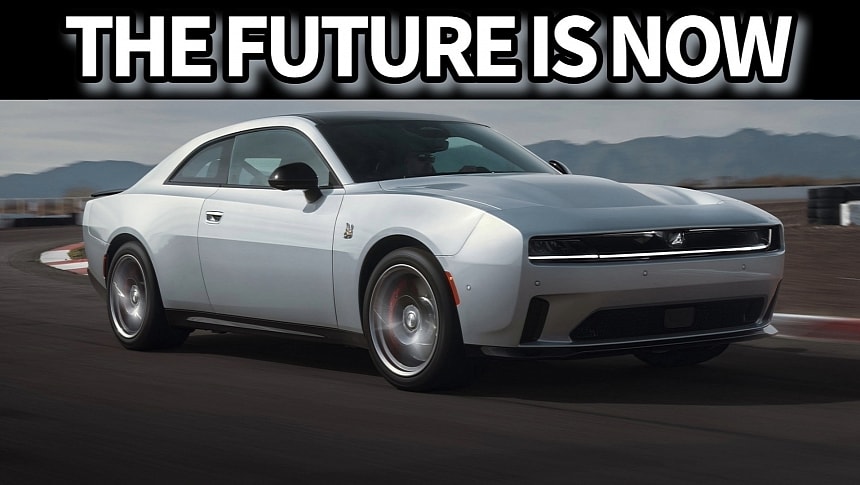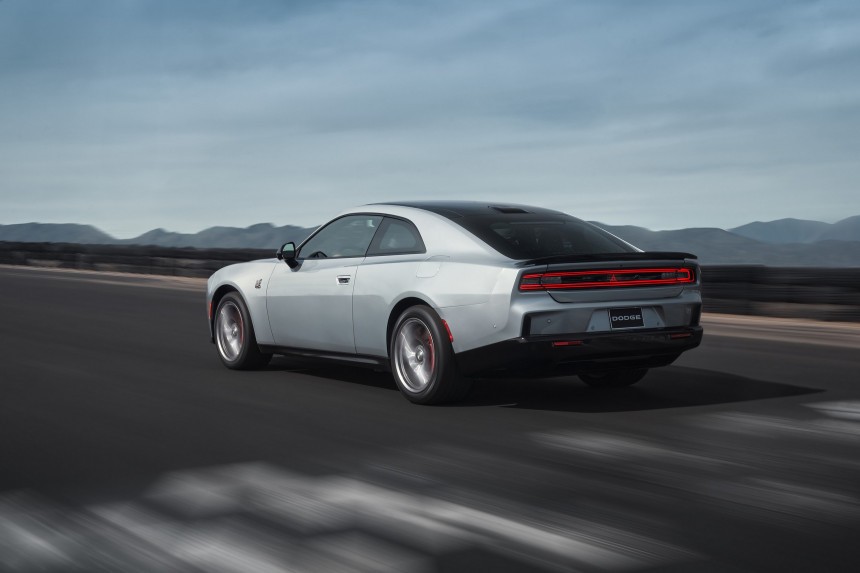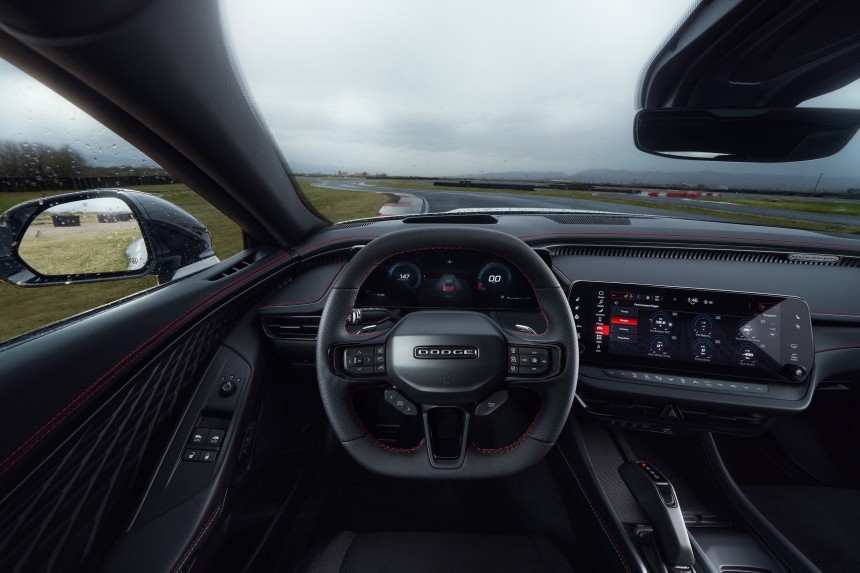We've known about the world's first electric muscle car for a good couple of years, and the official confirmation came when Dodge unveiled the Charger Daytona SRT Concept in 2022. Fast-forward to this week, and it's the main topic on the lips of petrolheads of all ages.
It's hard to believe we now have an electric muscle car from Dodge. Well, muscle car in theory and shape, anyway, as this class was always about V8 firepower wrapped in a chunky-looking package that could eat straight roads and struggled to corner properly. But here we are, faced with such a machine that keeps one foot in the present by still offering ICE alternatives and one in the future having gone down the EV route.
Zero tailpipe emissions are officially a thing for the Dodge Charger Daytona, which has 496 horsepower (503 ps/370 kW) in the top form when it comes to the R/T and 670 hp (680 ps/500 kW) should you choose the Scat Pack. The latter tops the family and is estimated to reach 60 mph (97 kph) in 3.3 seconds and run the 1/4-mile in 11.5 seconds.
These models feature zero tailpipe emissions and are driven by a 400-volt propulsion system. Dodge says 800-volt models will join them further down the line. If the ICE-powered variants are on your shopping list, you will have to wait until early next year to get your hands on the Sixpack H.O. and Sixpack S.O., featuring the 3.0L twin-turbo Hurricane engine that makes 550 and 420 hp (558-426 ps/410-313 kW), respectively. That is also when the four-door Charger will launch.
Tipping the scales at over 4,000 pounds (1,800+ kg) depending on the specification, the old Dodge Challenger wasn't exactly a featherweight. However, it seems one compared to the new Charger Daytona, which weighs over 5,800 pounds (2,630+ kg). It is also much longer, measuring 206.6 inches (5,248 mm) from bumper to bumper, which makes it as long as a new Mercedes-Benz S-Class. The width and height are 79.8 and 58.9 inches (2,027-1,496 mm), respectively, and it has 121 inches (3,073 mm) between the axles.
Dodge has managed to retain the same overall length in the four-door Charger, too, which has an identical wheelbase. Heck, even the roof measures the same as it does on its coupe counterpart, with the only big differences being the number of doors it has and the shape and size of the windows. Thus, both should act the same regardless of whether we're talking about straight-line sprints or the occasional racetrack thrashing, and by the looks of it, we're in for a long wait to find out if they're any good and they truly do justice to this iconic moniker.
From a design perspective, Dodge's all-new Charger Daytona is a nod to the original Chargers. It has a new face that seems to have come to the 21st century straight from the '70s, a muscular hood design, a square front bumper, fat shoulders, a clean profile with a roofline that's arched towards the rear, and a cool lighting signature that occupies a good chunk of the trunk lid and protrudes into the rear quarter panels. In fact, the only things that could've looked better are the rear three-quarter design and the shape of the rear windscreen.
Its platform should be a clear indicator as to what to expect in terms of driving dynamics. However, this is the first production model to use the STLA Large. The upcoming Jeep Wagoneer S, Recon, Chrysler Airflow, and the next Maserati Levante and Quattroporte, expected in 2027 and 2028, respectively, will also use this construction that supports both EV and ICE powertrains, as we already mentioned. Other models will utilize this architecture in the next few years, so the trial-by-fire role goes to the new Charger Daytona – a strange move from Stellantis, Dodge's parent company, nonetheless.
From a design perspective, we're tempted to say this is a real muscle car. However, it's completely different than what we're used to, and even with the fake engine noise and dizzying straight-line sprints aided by the instant thrust of the electric motors, it's an eyebrow-raiser and will remain one until proven otherwise. You can bet everything on General Motors and Ford watching it closely and deciding what the best approach for their next muscle cars is, so it could go down in history either as a big win or a big fail.
Kudos to Dodge for daring to be different, but then again, they've already proved that they can make awesome muscle cars (ahem, the Demon 170) that can bring the straight-line battle to the hypercar territory. Do you have your eyes set on the new Charger Daytona? If so, what has convinced you to go for it, and if not, could a V8-powered muscly model take its place in your garage? And more importantly, do you consider it a real muscle car or just another EV nonsense aimed against the likes of Tesla's models?
Zero tailpipe emissions are officially a thing for the Dodge Charger Daytona, which has 496 horsepower (503 ps/370 kW) in the top form when it comes to the R/T and 670 hp (680 ps/500 kW) should you choose the Scat Pack. The latter tops the family and is estimated to reach 60 mph (97 kph) in 3.3 seconds and run the 1/4-mile in 11.5 seconds.
These models feature zero tailpipe emissions and are driven by a 400-volt propulsion system. Dodge says 800-volt models will join them further down the line. If the ICE-powered variants are on your shopping list, you will have to wait until early next year to get your hands on the Sixpack H.O. and Sixpack S.O., featuring the 3.0L twin-turbo Hurricane engine that makes 550 and 420 hp (558-426 ps/410-313 kW), respectively. That is also when the four-door Charger will launch.
Dodge has managed to retain the same overall length in the four-door Charger, too, which has an identical wheelbase. Heck, even the roof measures the same as it does on its coupe counterpart, with the only big differences being the number of doors it has and the shape and size of the windows. Thus, both should act the same regardless of whether we're talking about straight-line sprints or the occasional racetrack thrashing, and by the looks of it, we're in for a long wait to find out if they're any good and they truly do justice to this iconic moniker.
From a design perspective, Dodge's all-new Charger Daytona is a nod to the original Chargers. It has a new face that seems to have come to the 21st century straight from the '70s, a muscular hood design, a square front bumper, fat shoulders, a clean profile with a roofline that's arched towards the rear, and a cool lighting signature that occupies a good chunk of the trunk lid and protrudes into the rear quarter panels. In fact, the only things that could've looked better are the rear three-quarter design and the shape of the rear windscreen.
From a design perspective, we're tempted to say this is a real muscle car. However, it's completely different than what we're used to, and even with the fake engine noise and dizzying straight-line sprints aided by the instant thrust of the electric motors, it's an eyebrow-raiser and will remain one until proven otherwise. You can bet everything on General Motors and Ford watching it closely and deciding what the best approach for their next muscle cars is, so it could go down in history either as a big win or a big fail.
Kudos to Dodge for daring to be different, but then again, they've already proved that they can make awesome muscle cars (ahem, the Demon 170) that can bring the straight-line battle to the hypercar territory. Do you have your eyes set on the new Charger Daytona? If so, what has convinced you to go for it, and if not, could a V8-powered muscly model take its place in your garage? And more importantly, do you consider it a real muscle car or just another EV nonsense aimed against the likes of Tesla's models?
















